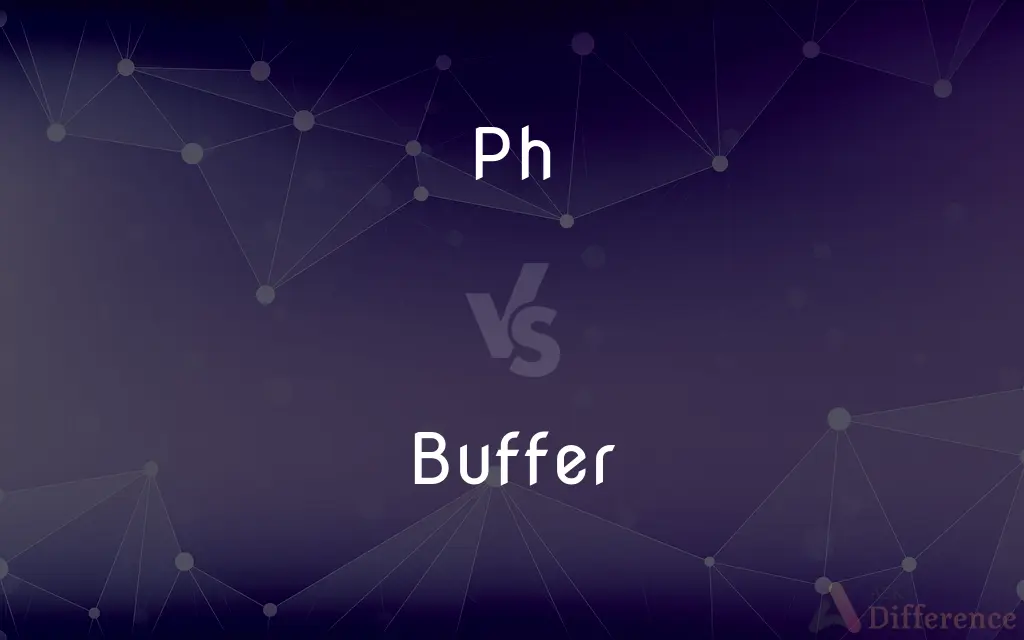pH vs. Buffer — What's the Difference?
By Tayyaba Rehman — Updated on September 27, 2023
pH measures acidity or alkalinity on a scale of 0-14; a buffer resists pH changes in solutions by neutralizing added acids or bases.

Difference Between pH and Buffer
Table of Contents
ADVERTISEMENT
Key Differences
pH is a logarithmic scale used to specify the acidity or alkalinity of an aqueous solution. It is measured on a scale of 0 to 14, with 7 being neutral. A pH less than 7 is acidic, and a pH greater than 7 is basic. pH is crucial in various scientific fields as it can influence the properties and behavior of substances, affect chemical reactions, and play a vital role in biological functions. For instance, the optimal pH for human blood is approximately 7.4, deviations from which can lead to health issues.
On the other hand, a buffer is a solution that can resist changes in pH when an acid or base is added to it. Buffers usually consist of a weak acid and its conjugate base or a weak base and its conjugate acid. They are pivotal in chemical and biological systems, helping to maintain a stable environment, known as homeostasis, by counteracting changes in hydrogen ion concentration. For example, bicarbonate ions in blood act as a buffer to maintain blood pH levels.
Understanding pH is essential to grasp the concept of buffers. pH measures the hydrogen ion concentration in a solution, providing insights into whether a solution is acidic, basic, or neutral. The significance of pH in biological and chemical contexts underscores its role in maintaining the correct conditions for optimal biochemical activity and reactions. For instance, enzymes, crucial in biological functions, have optimal pH levels at which they perform most efficiently.
A buffer’s role in resisting pH changes is crucial in numerous chemical and biological processes. By mitigating pH fluctuations, buffers stabilize the pH of a solution, making them essential in biological systems like the human body, where maintaining a consistent internal environment is vital. Buffers play a fundamental role in biochemical experiments as well, where controlling the pH is often crucial for the success of the experiment.
Comparison Chart
Definition
Measure of acidity or alkalinity in a solution.
Solution that resists changes in pH.
ADVERTISEMENT
Function
Indicates whether a solution is acidic, basic, or neutral
Maintains stable pH by neutralizing added acids/bases
Scale
Ranges from 0 to 14, 7 being neutral.
No scale; its effectiveness is in its composition
Composition
Not applicable, it’s a measure.
Consists of a weak acid and its conjugate base or vice versa.
Role in Biology
Influences enzymatic activity and biochemical reactions
Maintains homeostasis by stabilizing internal pH
Compare with Definitions
Ph
It is a scale used to measure the acidity or basicity of a solution.
Lemon juice has a low pH, indicating it is acidic.
Buffer
Contains a weak acid and its conjugate base or a weak base and its conjugate acid.
Acetic acid and sodium acetate form a buffer that can stabilize the pH of a solution.
Ph
Influences the properties and behaviors of substances.
The pH of soil affects the availability of nutrients to plants.
Buffer
It helps in maintaining homeostasis in biological systems.
Bicarbonate ions act as a buffer in blood, preventing drastic changes in pH.
Ph
It indicates the concentration of hydrogen ions in a solution.
A pH below 7 means the solution has more hydrogen ions and is acidic.
Buffer
It is a solution that resists changes in pH when an acid or base is added.
A buffer was added to the solution to maintain a constant pH during the experiment.
Ph
Neutral pH is 7, representing a balance between acid and base.
Pure water has a pH of 7, making it neutral.
Buffer
Essential in biochemical experiments for controlling the pH of the solution.
Researchers often use a buffer to create a suitable environment for biological molecules.
Ph
It is crucial in chemical reactions and biological functions.
Maintaining the correct pH is vital for optimal enzyme activity.
Buffer
One that buffs, especially a piece of soft leather or cloth used to shine or polish.
Ph
A measure of the acidity or alkalinity of a solution, numerically equal to 7 for neutral solutions, increasing with increasing alkalinity and decreasing with increasing acidity. The pH scale commonly in use ranges from 0 to 14.
Buffer
A buffing wheel.
Ph
Abbr of phot
Buffer
Something that lessens or absorbs the shock of an impact.
Ph
Initialism of physical health
Buffer
One that protects by intercepting or moderating adverse pressures or influences
"A sense of humor ... may have served as a buffer against the ... shocks of disappointment" (James Russell Lowell).
Ph
A notation used in transcripts to indicate that the transcriber does not know the spelling, usually of a name, and has spelled it as it was pronounced (phonetically)
Buffer
Something that separates potentially antagonistic entities, as an area between two rival powers that serves to lessen the danger of conflict.
Ph
(chemistry) p(otential of) H(ydrogen); the logarithm of the reciprocal of hydrogen-ion concentration in gram atoms per liter; provides a measure on a scale from 0 to 14 of the acidity or alkalinity of a solution (where 7 is neutral and greater than 7 is acidic and less than 7 is basic)
Buffer
(Chemistry) A solution that resists a change in acidity when an acid or base is added to it, or a substance that facilitates this resistance.
Buffer
(Computers) A device or area used to store data temporarily.
Buffer
To act as a buffer for or between.
Buffer
(Chemistry) To treat (a solution) with a buffer.
Buffer
(Computers) To hold or collect (data) in a buffer.
Buffer
An elastic apparatus or fender, for deadening the jar caused by the collision of bodies; as, a buffer at the end of a railroad car.
Buffer
One who polishes with a buff.
Buffer
A wheel for buffing; a buff.
Buffer
A good-humored, slow-witted fellow; - usually said of an elderly man.
Buffer
A substance or mixture of substances which can absorb or neutralize a certain quantity of acid or base and thus keep the degree of acidity or alkalinity of a solution (as measured by pH) relatively stable. Sometimes the term is used in a medical context to mean antacid.
Buffer
A data storage device or portion of memory used to temporarily store input or output data until the receiving device is ready to process it.
Buffer
Any object or person that shields another object or person from harm, shock, or annoyance; as, the President's staff is his buffer from constant interruptions of his work.
Buffer
To add a buffer{5} to (a solution), so as to reduce unwanted fluctuation of acidity.
Buffer
An ionic compound that resists changes in its pH
Buffer
An inclined metal frame at the front of a locomotive to clear the track
Buffer
(computer science) a part of RAM used for temporary storage of data that is waiting to be sent to a device; used to compensate for differences in the rate of flow of data between components of a computer system
Buffer
A power tool used to buff surfaces
Buffer
A cushion-like device that reduces shock due to contact
Buffer
An implement consisting of soft material mounted on a block; used for polishing (as in manicuring)
Buffer
Add a buffer (a solution);
Buffered saline solution for the eyes
Buffer
Protect from impact;
Cushion the blow
Buffer
Can neutralize added acids or bases to maintain stability.
Buffers are crucial in preventing pH fluctuations in aquariums, keeping fish healthy.
Common Curiosities
What is the purpose of a Buffer?
A buffer maintains a stable pH in a solution by neutralizing added acids or bases.
How is pH represented?
pH is represented on a scale from 0 (acidic) to 14 (alkaline), with 7 being neutral.
Can a Buffer be acidic or basic?
Yes, buffers can be acidic or basic depending on their composition.
What is the importance of pH in biology?
pH is crucial in biology as it affects enzyme activity and cellular function.
What does pH measure?
pH measures the acidity or alkalinity of a solution.
Can a Buffer solution be prepared in a lab?
Yes, buffer solutions are commonly prepared in labs to control the pH of experiments.
Are Buffers essential in pharmaceutical products?
Yes, buffers are crucial in pharmaceuticals to maintain the product’s pH stability.
Does pH influence chemical reactions?
Yes, pH can significantly influence the rate and outcome of chemical reactions.
Can pH affect solubility of substances?
Yes, pH can impact the solubility of substances, especially those that are pH-sensitive.
How does a Buffer work?
A buffer works by releasing or absorbing hydrogen ions to resist changes in pH.
Is a low pH acidic or basic?
A low pH represents an acidic solution.
How do buffers maintain homeostasis in organisms?
Buffers stabilize internal pH, essential for maintaining physiological balance or homeostasis.
Is maintaining pH important in environmental science?
Yes, maintaining pH is vital in environmental science, as it affects ecosystems and biodiversity.
How is a Buffer chosen for an experiment?
Buffers are chosen based on their pKa values and the desired pH of the experiment.
What substances typically have a pH of 7?
Pure water and other neutral solutions typically have a pH of 7.
Share Your Discovery

Previous Comparison
Merchandising vs. Marketing
Next Comparison
Larceny vs. TheftAuthor Spotlight
Written by
Tayyaba RehmanTayyaba Rehman is a distinguished writer, currently serving as a primary contributor to askdifference.com. As a researcher in semantics and etymology, Tayyaba's passion for the complexity of languages and their distinctions has found a perfect home on the platform. Tayyaba delves into the intricacies of language, distinguishing between commonly confused words and phrases, thereby providing clarity for readers worldwide.














































